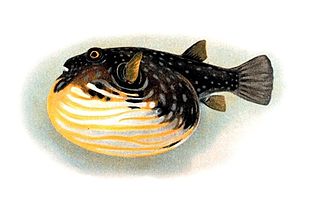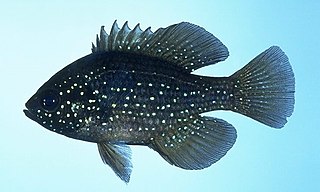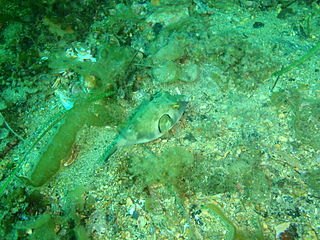
Tetraodontidae is a family of primarily marine and estuarine fish of the order Tetraodontiformes. The family includes many familiar species variously called pufferfish, puffers, balloonfish, blowfish, blowers, blowies, bubblefish, globefish, swellfish, toadfish, toadies, toadle, honey toads, sugar toads, and sea squab. They are morphologically similar to the closely related porcupinefish, which have large external spines. The scientific name refers to the four large teeth, fused into an upper and lower plate, which are used for crushing the hard shells of crustaceans and mollusks, their natural prey.

The Guadalupe fur seal is one of eight members of the fur seal genus Arctocephalus. They are the northernmost member of this genus. Sealers reduced the population to just a few dozen by the late 19th century, but the species had recovered to 10,000 in number by the late 1990s. Many individuals can be found on Mexico's Guadalupe Island.

The bluespotted ribbontail ray is a species of stingray in the family Dasyatidae. Found from the intertidal zone to a depth of 30 m (100 ft), this species is common throughout the tropical Indian and western Pacific Oceans in nearshore, coral reef-associated habitats. It is a fairly small ray, not exceeding 35 cm (14 in) in width, with a mostly smooth, oval pectoral fin disc, large protruding eyes, and a relatively short and thick tail with a deep fin fold underneath. It can be easily identified by its striking color pattern of many electric blue spots on a yellowish background, with a pair of blue stripes on the tail.

Kuhl's maskray, also known as the blue-spotted stingray, blue-spotted maskray, or Kuhl's stingray, is a species of stingray of the family Dasyatidae. It was recently changed from Dasyatis kuhlii in 2008 after morphological and molecular analyses showed that it is part of a distinct genus, Neotrygon. The body is rhomboidal and colored green with blue spots. Maximum disk width is estimated 46.5 cm (18.3 in). It is popular in aquaria, but usually not distinguished from the blue-spotted ribbontail ray. The ribbontail has a rounded body, is a brighter green with brighter blue and more vivid spots, but Kuhl's maskray is larger. The stingray's lifespan is estimated at 13 years for females and 10 years for males. The blue-spotted stingray preys on many fish and small mollusks. It is also generally found from Indonesia to Japan, and most of Australia. Kuhl's maskray also is targeted by many parasites, such as tapeworms, flatworms, and flukes.

The Croatan National Forest is a U.S. National Forest, was established on July 29, 1936, and is located on the Atlantic coast of North Carolina. It is administered by the United States Forest Service, a part of the United States Department of Agriculture. The forest is managed together with the other three North Carolina National Forests from common headquarters in Asheville, North Carolina. However, Croatan has a local ranger district office in New Bern.

Cephalopholis is a genus of marine ray-finned fish, groupers from the subfamily Epinephelinae in the family Serranidae, which also includes the anthias and sea basses. Many of the species have the word "hind" as part of their common name in English.

Pagrus is a genus of fish in the family Sparidae. It contains at least six described species:

Omegophora is a genus of pufferfishes native to the coastal waters of Australia.

Neotrygon is a genus of stingrays in the family Dasyatidae commonly known as the Maskrays, native to the Indo-West Pacific. They are so named because of a distinctive color pattern around their eyes, resembling a mask. The species in this genus were originally placed in the genus Dasyatis by most authors. However, recent morphological and molecular analyses have conclusively showed that they represent a distinct group and so the genus Neotrygon was resurrected for them.

Chaetodontoplus caeruleopunctatus, the bluespotted angelfish, is a species of marine ray-finned fish, a marine angelfish belonging to the family Pomacanthidae. It is from the Western-Pacific Ocean.

Cephalopholis taeniops, the African hind, bluespotted sea bass or spotted grouper, is a species of marine ray-finned fish, a grouper from the subfamily Epinephelinae which is in the family Serranidae which also includes the anthias and sea basses. This species occasionally makes its way into the aquarium trade and is a target for local fisheries. It is found in the eastern Atlantic Ocean.

Balistes punctatus, the bluespotted triggerfish or simply spotted triggerfish, is a species of triggerfish from the Eastern Atlantic. It occasionally makes its way into the aquarium trade. It can grow to a size of 60 centimetres (24 in) total length but typically is much smaller.

The bluespotted trevally, also known as the wide-mouthed trevally, is a species of moderately large marine fish in the jack family Carangidae. The bluespotted trevally is distributed through the tropical east Indian and west Pacific Oceans, ranging from Taiwan in the north to Australia in the south. It is an inshore species, found in sandy, muddy and seagrass environments, often in large bays. The bluespotted trevally is distinguished by dark blue spots on its upper body, as well as a number of more detailed anatomical features. It is a benthopelagic predator, taking a variety of crustaceans including crabs and prawns as a juvenile, before shifting to a more fish-dominated diet as an adult. It is one of the most common predators in the Gulf of Carpentaria of northern Australia, and is considered the most important predator of commercially important prawn species. Sexual maturity is reached at 110 mm in length and one year of age, with spawning occurring year round with a peak in spring. Growth is estimated to be 82.2 mm per year for both sexes, reaching a maximum known length of 66 cm. Bluespotted trevally are commonly taken as bycatch in prawn fisheries, however are of little commercial value and often discarded. They are occasionally taken by anglers on lures and baits, but are considered mediocre table fare.

The bluespotted cornetfish, also known as smooth cornetfish or smooth flutemouth, is a marine fish which belongs to the family Fistulariidae. This very long and slender reef-dweller belongs to the same order as the pipefishes and seahorses, called Syngnathiformes.

The bluespotted sunfish is a species of fish in the family Centrarchidae, the sunfishes. It is native to the southeastern and eastern United States, its distribution extending as far north as New Jersey, Pennsylvania, and far southern New York. It is native throughout most of its range, but some populations represent introductions, such as those in Lake Ontario and the upper Susquehanna River system.

The bluespotted poacher is a fish in the family Agonidae. It was described by Charles Henry Gilbert in 1890, originally in the genus Xenochirus. It is a marine, deep water-dwelling fish which is known from British Columbia, Canada to northern central Baja California, Mexico, in the eastern Pacific Ocean. It dwells at a depth range of 73–373 metres, and inhabits soft benthic sediments. Males can reach a maximum total length of 18 centimetres.

Platycephalus caeruleopunctatus, the bluespotted flathead, drift flathead, Eastern blue-spot flathead, longnose flathead, red flathead, red spotted flathead, sand flathead or yank, is a species of predatory ray-finned fish belonging to the family Platycephalidae, the flatheads. Bluespotted flathead are a marine species and are predominantly found in offshore waters and coastal bays on the east coast of Australia where they are almost exclusively found on marine sand.

The ringed toadfish is a species of puffer in the family Tetraodontidae. It grows up to 25 cm (9.8 in) in length, and is poisonous to consume. It has a black ring surrounding its pectoral fins, and an oval-like body covered in small spines.
Platycephalus endrachtensis, or the bar-tailed flathead, bar-tail flathead, flag-tail flathead, northern sand flathead, northern-flag tailed flathead, sand flathead, western estuary flathead, is a predatory fish in the family Platycephalidae. It is found from the eastern Indian Ocean to the western Pacific, including in Australian and Indonesian waters up to 60 m (200 ft) deep over sand, at temperatures between 17 and 18 °C. The maximum length of the species is 62 cm (24 in), and its weight up to 5 kg (11 lb). A popular angling species, the specific epithet endrachtensis refers to Eendrachtsland, an early Dutch name for Australia, with the suffix -ensis, meaning "place". Venomous spines are hazardous for safe handling.
Chelonodontops laticeps, also known as the bluespotted blaasop, is a species of pufferfish in the family Tetraodontidae. It is native to the western Indian Ocean on the coast of Africa, from South Africa north to Tanzania, and around Madagascar. FishBase includes also Papua New Guinea in its range.

















